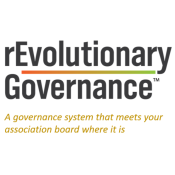
Why Your Association’s Strategic Plan Can’t Fix Your Culture
Strategic planning is a standard exercise at many, if not most, associations/nonprofit organizations. So much so that many smart people mindlessly use it as a prescription for all organizational ills: “Having problems, eh? Do you have a strategic plan? If you do, when was the last time you looked at it?” — as if the only reason why an organization is struggling is because it doesn’t have a strategic plan or isn’t using it.
Not only that, most traditional planning methodologies are not strategic to begin with and put the focus of leadership in the wrong place.
Most planning approaches spend an inordinate amount of time on management/operations activities and quickly shift the Board of Directors’ focus from leadership to management. The traditional Strategic Planning Pyramid is illustrated below.

What most call “strategic planning” is largely operational, not strategic; it is, in fact, project planning methodology. And this methodology is fine when it is applied to project management. In fact, it’s the best approach to take when hard deadlines exist and detailed action plans are critical. For example, when planning conferences/trade shows, product launches, marketing plans, publications, etc. – anything that has logical steps, firm deadlines and lots of details.
But it’s the wrong tool for strategic leadership. Values aren’t steps in a plan. Vision is not a project and it doesn’t have a deadline. A strategy is a choice, a focus, not a destination, and it requires an agility that a written plan in and of itself can’t provide.
Organizational culture doesn’t operate using goals, objectives and action plans. Attitudes and mindset can’t be effectively influenced by a plan. But the opposite is true. Execution of vision, strategies, goals, etc., is influenced by organizational culture, attitudes and mindset – particularly if they are unsupportive of the effort.
That means focusing leadership on mindset (people), not goals/objectives and action plans (process), which is a function of management and line-level execution (i.e., committees and staff).
The New School of Strategic Leadership
Instead of using the old-school “Strategic Planning Pyramid” as the paradigm for the board and CEO’s strategy work, consider a new paradigm called the “Strategic Leadership Pyramid,” which is illustrated below.

You’ll note that none of the activities in the Strategic Leadership Pyramid include goals, objectives, action plans, key performance metrics, etc. Planning methods are great tools for personal and team time management, as well as focusing team activities as they execute complex projects. But they are tools for the operational work of staff and committees, not the Board of Directors and executive. They are management tools, not strategic leadership tools.
Aspirational Culture is at the top of the pyramid, not Vision. Why? “The way we do things around here” frequently supersedes desired outcomes. “Culture eats strategy for breakfast,” a quote attributed to Peter Drucker, captures this idea. By necessity, leadership focus must begin with organization culture. Culture is the pipe through which vision and strategy flow and it must be unobstructed to ensure effective strategic execution.
Vision and Values are among the few items from the traditional Strategic Planning Pyramid that remain on the Strategic Leadership Pyramid. They belong there because they are aspirational and inspirational, not operational or tactical. Strategic focus areas are another area of crossover. Obviously, strategies are strategic.
Co-creating and telling the story means describing vision and strategic focus in a compelling story format that is memorable and actionable. And the story needs to have specific relevance. That means, it’s not just leadership’s story. If I’m the office receptionist, I know my part of the story, and it’s personal, not general. And I can articulate it and play the role, too.
Last — and this is where strategy gets operationalized in case you’re wondering how strategic focus becomes manageable and measurable without the goals, objectives, action plans and the like — is ongoing strategic conversations. Instead of going back into an operational, project management-type approach, leaders engage in ongoing strategic conversations with the operationalizers and focus on creating context for decision-making.
In typical strategy processes, staff and committees either develop or are provided with and measured by checklists, and success is measured by checking off items on the lists (process management). This only measures what has/has not been completed (lagging indicators that cannot be changed), not whether those implementing the vision have an innate understanding of what should be done, a strategic mindset, and the ability to take intuitively aligned actions (leading indicators of alignment). These can only be identified through strategic conversation.
Through strategic conversation, the board and staff executive leadership should provide the container of context within which plans and outcomes are created, not the plans themselves. While leadership should establish broad, written strategic goals, it is more important that they to “tell the story” in a way that allows for staff and committees to execute with or without detailed action plans. Let’s discuss your strategic plans. Contact us.




